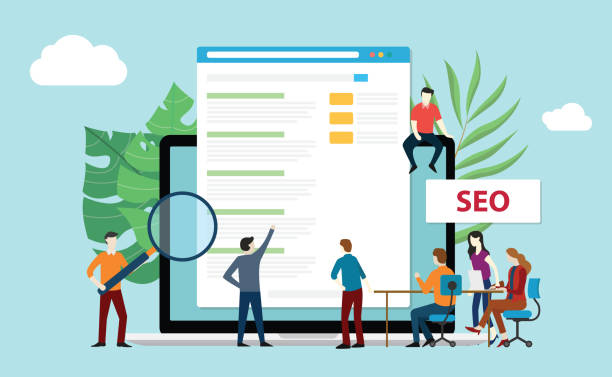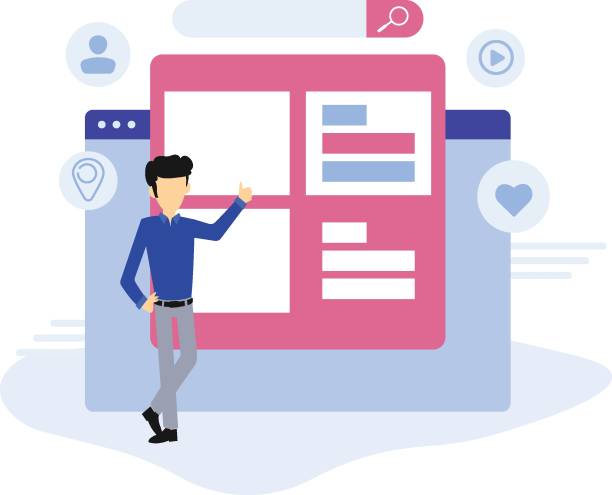Why is User-Friendly Website Design Crucial?

In today’s highly competitive world, merely having a website is not enough for businesses.
What matters is user-friendly website design; a website that is easy to navigate, meets users’ needs, and provides a pleasant experience for them.
#UserExperience #CustomerSatisfaction #SEO #BusinessGrowth.
A user-friendly website not only increases conversion rates and user retention but also plays a key role in improving the site’s ranking in search engines.
If users cannot easily find the information they need or encounter a complex process for purchasing or signing up, they will quickly leave your site and go to your competitors.
This directly impacts your brand’s credibility.
The importance of user-friendly website design goes beyond a beautiful appearance; it is a smart strategy for effective communication with your audience, increasing sales, and building a strong and trustworthy brand.
Your website should be a visual and practical guide for your audience, leading them towards their goals, whether that goal is purchasing a product, finding information, or making contact.
Therefore, investing in this area is an investment in your business’s long-term success.
This section provides an explanation to help you understand why you should care about this concept.
Is your e-commerce site ready to attract maximum customers and increase sales? Rasaweb transforms your online business with modern and efficient e-commerce website designs.
✅ Increased speed and improved SEO
✅ Excellent user experience on mobile and desktop⚡ Get a free consultation for e-commerce website design from Rasaweb!
Core Principles of User Experience (UX) in Web Design

User Experience (UX) is the heart of user-friendly website design.
This concept goes beyond the aesthetics of a website and refers to all user interactions with a product or service.
Core UX principles include Usability, Accessibility, Desirability, Value, and Findability.
Usability means that users can easily and without confusion interact with the website and perform their tasks.
This includes intuitive navigation, simple forms, and clear error messages.
Accessibility means designing the website for all users, including people with disabilities who use assistive technologies like screen readers.
Desirability refers to emotional and visual aspects that make the user enjoy using the website and want to return.
Value means that the website should address real user needs and provide meaningful solutions.
Findability refers to important information and content being easily discoverable by the user, whether through internal search or a consistent site structure.
Learning these principles is essential for every web designer and business owner to create a truly user-friendly website design that benefits both the user and the business.
The Role of User Interface (UI) Design in User’s Visual Experience

While UX addresses how the website functions and how the user feels about it, User Interface (UI) design relates to the website’s visual appearance and feel.
UI includes all visual and interactive elements of a website, such as buttons, icons, images, typography, color palette, and page layout.
A good and attractive UI improves the user experience and makes the website visually appealing and functionally efficient.
For user-friendly website design, the balance between UI and UX is crucial; a beautiful design without good functionality frustrates the user, and conversely, a functional but messy website will discourage the user.
Choosing appropriate fonts, a brand-consistent and readable color scheme, and logical organization of elements on the page all contribute to creating a desirable visual experience.
Also, proper use of whitespace is important to reduce clutter and guide the user’s eye towards the main content.
The table below shows some common UI elements and their role in user experience, which is useful for professionals in this field:
| UI Element | Role in User Experience |
|---|---|
| Buttons | Guiding the user to a specific action (purchase, signup, download) |
| Navigation Menus | Helping to find information and easy access to different pages |
| Form Fields | Collecting information from the user simply and clearly |
| Icons | Providing quick visual information and reducing the need for text |
| Images & Videos | Attracting attention, explaining complex concepts, and creating a pleasant feeling |
| Typography | Increasing text readability and conveying brand tone |
These elements must be carefully and consistently chosen to provide the best user-friendly website design.
Responsive Design and Mobile-First Approach for Accessibility

In the current era, a significant portion of web traffic comes from mobile devices.
Therefore, having a responsive design is a requirement, not an option, for user-friendly website design.
Responsive design means your website automatically adjusts its layout and content to the user’s screen size (mobile, tablet, laptop, desktop) to provide the best possible experience.
This approach ensures that users, regardless of the device they use, can easily navigate your website.
In addition to responsiveness, the “Mobile-First” approach has gained increasing importance.
In this approach, website design is initially done for the smallest screen (usually mobile) and then gradually scaled up for larger screens.
This method ensures that essential features and main content are prioritized and the mobile user experience is optimized.
Google also places great importance on mobile compatibility and ranks non-responsive websites lower.
By doing this, you provide a comprehensive guide for your users and ensure that every visitor, regardless of their device, can easily interact with and benefit from your site.
This is a crucial aspect of user-friendly website design that should not be overlooked.
Tired of losing customers due to poor e-commerce website design? With Rasaweb, solve this problem forever!
✅ Increase sales and conversion rates from visitors to customers
✅ Smooth and attractive user experience for your customers⚡ Get a free consultation
Content Strategy for User-Friendly Websites

Content is king, but not just any content.
For user-friendly website design, content strategy must be built on clarity, conciseness, relevance, and value.
Your content should answer users’ questions, guide them, and help them achieve their goals.
Using simple and understandable language, avoiding complex jargon (unless your audience is specialized), and logically organizing information are key to user-friendly content.
Creating thought-provoking content that encourages users to think and interact can significantly increase engagement.
For example, you can include surveys, quizzes, or discussion-leading articles on your site.
This analytical approach helps you identify real user needs and produce content that is truly beneficial for them.
In addition to text, using images, infographics, and videos is essential for explaining complex concepts and enhancing visual appeal.
These visual elements can convey a lot of information to the user in less time and make the reading experience more enjoyable.
Also, the Call-to-Action (CTA) should be clear and prominent so users know what the next step is.
A user-friendly website design requires content that is both informative and guides users towards business goals.
Optimizing Website Speed and Performance for a Better Experience

Website loading speed is one of the most important factors in user-friendly website design as well as search engine ranking.
Today’s users expect websites to load quickly; even a few seconds delay can lead to losing visitors.
Research shows that many users abandon a website if it doesn’t load within 3 seconds.
Several measures can be taken to optimize speed: image optimization (compression without quality loss), caching, code minification, and using Content Delivery Networks (CDNs) are among them.
Each of these actions helps reduce page load time.
For example, by compressing images, file sizes are reduced, and the browser can download them faster.
Using a CDN means that your website’s content is served from the closest server to the user, which reduces latency and increases loading speed.
This technical aspect of user-friendly website design is often overlooked but directly impacts user satisfaction and even conversion rates.
Search engines also consider site speed as an important ranking factor, so performance optimization is crucial not only for users but also for SEO.
This is an explanation of the technical aspects of speed optimization that helps you improve site performance.
User Testing and Continuous Feedback

To ensure that your user-friendly website design truly meets user needs, conducting user testing and gathering feedback is essential.
Your assumptions about how users interact with the website might be wrong; the only way to find out the truth is to observe real users while they are using the site.
There are various methods for user testing, including A/B testing, user interviews, heatmaps, and eye-tracking.
A/B testing allows you to compare two different versions of a page or element to see which one performs better.
User interviews can provide deeper insights into their motivations and problems.
Heatmaps show where users click or focus most on the page, while eye-tracking provides more detailed information about their visual patterns.
A journalistic and analytical approach for this section could include case studies of companies that have optimized their websites through continuous testing.
This process should be ongoing because user needs and expectations are constantly changing, and to maintain a user-friendly website design, you must regularly update your website.
The table below shows some of the most common user testing methods:
| Test Method | Primary Goal |
|---|---|
| A/B Testing | Comparing two versions of an element or page to determine the best performance |
| User Interview | Gathering qualitative feedback and gaining deeper understanding of user needs and problems |
| Heatmaps | Analyzing user click and focus points on the page |
| Card Sorting | Helping to design logical information architecture and intuitive navigation |
| Surveys and Feedback Forms | Collecting general opinions and suggestions from users |
These methods are powerful tools for user-friendly website design.
Accessibility in Web Design for Everyone

Accessibility means designing a website that can be used by everyone, regardless of their abilities or disabilities.
This includes people with visual, hearing, motor, or cognitive impairments.
Ignoring accessibility not only prevents a large segment of users from accessing your services but can also lead to legal issues.
For a truly user-friendly website design, accessibility must be considered from the outset.
This involves using alt tags for images (which are read by screen readers), ensuring sufficient contrast between text and background, keyboard navigation capability for users who cannot use a mouse, and providing captions or transcripts for audio and video content.
The Web Content Accessibility Guidelines (WCAG) by the World Wide Web Consortium (W3C) provide standards for this purpose that must be followed.
An accessible website not only demonstrates your social responsibility but also expands your target market and creates a positive experience for everyone.
This is a fundamental principle in user-friendly website design that must be given specialized attention and implemented in the best possible way through necessary training and guidance.
Does your current site portray your brand’s credibility as it should? Or does it drive away potential customers?
Rasaweb, with years of experience in professional corporate website design, is your comprehensive solution.
✅ A modern, beautiful site tailored to your brand identity
✅ Significantly increased lead generation and new customers
⚡ Contact Rasaweb now for a free corporate website design consultation!
The Future of User-Friendly Website Design: AI and Personalization

The future of user-friendly website design is rapidly evolving with technological advancements.
Artificial Intelligence (AI) and Machine Learning (ML) play an increasingly significant role in personalizing the user experience.
By using user data, AI can uniquely tailor content, products, and even website layout based on each user’s preferences and behavior.
This personalization can include product recommendations, customized content, or even changes in the user interface, making the experience highly engaging and relevant.
Other future trends include Voice User Interfaces (Voice UI), which allow users to interact with websites via voice commands, as well as Augmented Reality (AR) and Virtual Reality (VR), which can offer immersive and new interactive experiences.
However, even with these advanced technologies, the fundamental principles of user-friendly website design will remain constant: simplicity, clarity, efficiency, and focus on user needs.
This is an analysis of future trends that helps you prepare for upcoming challenges and opportunities and get your website ready for the future.
Measuring Success and Continuous Improvement in User-Friendly Design

The final and perhaps most important step in the journey of user-friendly website design is measuring success and committing to continuous improvement.
Website design is not a one-time process; rather, it is a continuous cycle of design, implementation, testing, feedback collection, and optimization.
To measure success, you need to define Key Performance Indicators (KPIs), such as Bounce Rate, Time on Site, Conversion Rate, and Customer Satisfaction.
Analytical tools like Google Analytics can provide valuable data for you to understand user behavior and identify weaknesses in your website.
Based on this data and feedback collected from user tests, you should make necessary changes and regularly update the site.
This iterative approach ensures that your website always aligns with user needs and market changes.
Remember that a truly user-friendly website design is never finished; there is always room for improvement.
This is the concluding guidance, emphasizing that success in this field requires an educational and dynamic approach that never stops.
Frequently Asked Questions
And other services of Rasa Web advertising agency in the field of advertising
Smart Reportage: A professional solution for user interaction with a focus on attractive UI design.
Smart Conversion Rate Optimization: A specialized service for growth in customer acquisition based on precise audience targeting.
Smart Content Strategy: Professional optimization for campaign management using attractive UI design.
Smart Direct Marketing: Designed for businesses seeking online growth through attractive UI design.
Smart Digital Advertising: An innovative service for increasing customer behavior analysis through optimizing key pages.
And over hundreds of other services in the field of internet advertising, advertising consultation, and organizational solutions
Internet Advertising | Advertising Strategy | Advertorials
Resources
Principles of Successful Website Design
Importance of UX/UI Design in Websites
What is User Experience (UX) Design?
The Role of User Experience in Website Design
? For a big leap in your business and reaching the peak of success, Rasaweb Digital Marketing Agency is by your side with its specialized services. Have a powerful online presence right now with fast and professional website design.
📍 Tehran, Mirdamad Street, next to Central Bank, Southern Kazeroon Alley, Ramin Alley, No. 6
